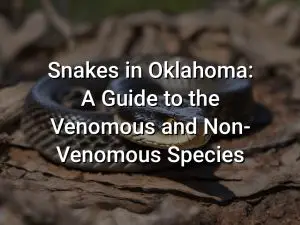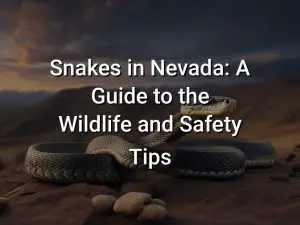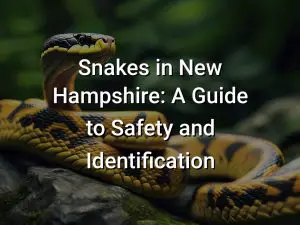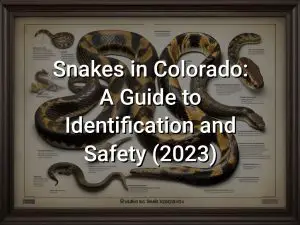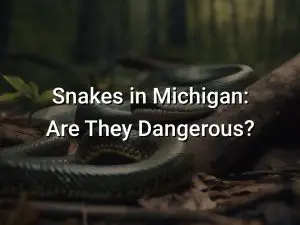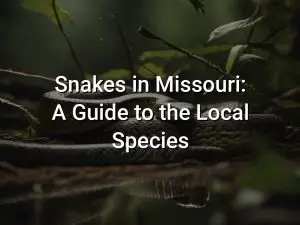Snakes in Mississippi: What You Need to Know (2023 Update)
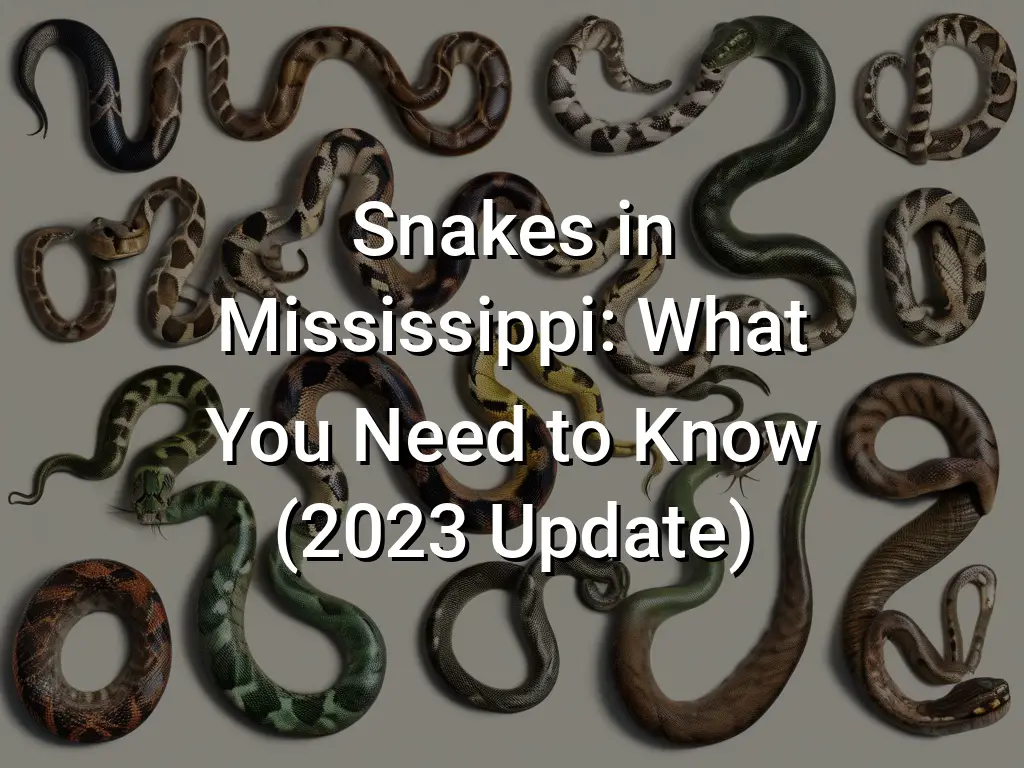
Calling all snake enthusiasts and curious minds! If you find yourself in Mississippi or are planning a visit, it’s important to be informed about the fascinating world of snakes. Mississippi is home to a diverse snake population, including both venomous and non-venomous species. From identification tips to snakebite prevention, this article will cover everything you need to know about snakes in Mississippi.
Discover the most common snakes found in Mississippi, learn how to identify them, and find out how to stay safe while exploring the great outdoors. We’ll also dive into the conservation efforts in place to protect these slithery creatures and share the best spots to catch a glimpse of them in their natural habitat. Say goodbye to snake myths and misconceptions as you become an expert on snakes in Mississippi!
Quick Links
Venomous Snakes in Mississippi
Mississippi is home to several species of venomous snakes, including:
- Copperhead: Copperheads are venomous pit vipers that are commonly found in wooded areas. They have a distinctive copper-colored head and hourglass-shaped markings on their bodies. Copperhead bites are rarely life-threatening but can be painful and cause swelling.
- Cottonmouth: Also known as water moccasins, cottonmouths are venomous snakes that are often found near water sources such as swamps, lakes, and rivers. They have a dark-colored body and a white mouth, which they open wide when feeling threatened. Cottonmouth bites can cause severe pain, swelling, and tissue damage.
- Rattlesnakes: Several species of rattlesnakes can be found in Mississippi, including the Eastern diamondback rattlesnake, timber rattlesnake, and pygmy rattlesnake. Rattlesnakes have a distinctive rattling noise that they make by shaking their tails. Rattlesnake bites can be life-threatening and require immediate medical attention.
It is important to exercise caution when encountering any snake in the wild and to give them their space. Most snake bites occur when people attempt to handle or kill the snake. If you are bitten by a venomous snake, seek medical attention immediately and try to stay calm to slow the spread of venom.
Remember, snakes play an important role in the ecosystem and should be respected and appreciated from a safe distance.
Non-venomous Snakes in Mississippi
In addition to venomous snakes, Mississippi is also home to a variety of non-venomous snakes. While these snakes may not pose a threat to humans, it is still important to exercise caution and avoid unnecessary contact. Here are some of the non-venomous snakes you may encounter in Mississippi:
- Black Rat Snake: This snake is known for its glossy black color and can grow up to six feet long. It is commonly found in forests and marshy areas.
- Eastern Hognose Snake: The Eastern Hognose Snake has a distinct upturned snout and is known for its habit of playing dead when threatened. It is typically found in sandy areas and grasslands.
- Eastern Milk Snake: With its vibrant colors and patterned body, the Eastern Milk Snake is often mistaken for the venomous Copperhead snake. However, it is harmless to humans and can be found in a variety of habitats.
- Ring-necked Snake: This small snake is known for its bright orange or yellow belly and distinctive ring around its neck. It can be found in wooded areas and is primarily active at night.
- Corn Snake: Corn snakes are popular pets due to their docile nature and attractive pattern. They can be found in a variety of habitats, including forests, fields, and even residential areas.
Remember, even if a snake is non-venomous, it is best to observe from a safe distance and not attempt to handle or provoke it. If you encounter a snake and are unsure of its species, it is always recommended to contact a local wildlife expert or snake removal service for assistance.
Mississippi’s Most Common Snakes
Mississippi is home to a diverse range of snake species, both venomous and non-venomous. It’s important to familiarize yourself with the most common snakes in the state to ensure your safety and to appreciate the unique wildlife that Mississippi has to offer.
One of the most frequently encountered venomous snakes in Mississippi is the Eastern Diamondback Rattlesnake. This large and highly venomous snake is typically found in wooded areas and can deliver a potent bite if provoked. It’s important to give this snake a wide berth and avoid any interactions.
Another venomous snake found in Mississippi is the Copperhead Snake. These snakes are known for their distinctive copper-colored head and are commonly found in forests, swamps, and rocky areas. While their venom is relatively mild compared to other venomous snakes, it’s still important to exercise caution and avoid handling them.
Mississippi is also home to several non-venomous snake species, including the Black Rat Snake. These snakes are excellent climbers and are commonly found in trees, barns, or abandoned buildings. While they may look intimidating, they are harmless and play an important role in controlling rodent populations.
The Eastern King Snake is another non-venomous snake found in Mississippi. These snakes are known for their striking black and yellow or black and white coloration, which resembles that of the venomous Eastern Coral Snake. However, Eastern King Snakes are perfectly harmless and are even known for their ability to prey on venomous snakes, making them beneficial to have around.
The Mississippi Garter Snake is a non-venomous snake commonly found near bodies of water, such as streams or ponds. These snakes are usually green or brown with three bright stripes running along their body. They are harmless and feed mainly on small fish, amphibians, and invertebrates.
It’s important to remember that snakes play a vital role in the ecosystem and should be respected from a distance. If you encounter a snake, give it space and observe it from a safe distance. It’s always best to leave snake handling to the professionals to ensure your safety and the well-being of the snakes.
Snake Identification Tips
When encountering snakes in Mississippi, it’s important to be able to identify them accurately. While some snakes are harmless, others may be venomous and pose a potential threat. Here are some tips to help you identify snakes in Mississippi:
- Color and Pattern: Look at the snake’s color and pattern. Many venomous snakes in Mississippi have distinct patterns, such as diamond-shaped patterns on their backs or bands of color.
- Head Shape: Pay attention to the shape of the snake’s head. Venomous snakes in Mississippi generally have a triangular-shaped head, while non-venomous snakes often have a more rounded head.
- Pupil Shape: Check the shape of the snake’s pupils. Venomous snakes in Mississippi typically have vertical, slit-like pupils, while non-venomous snakes have round pupils.
- Size: Consider the size of the snake. Venomous snakes in Mississippi are generally larger in size, while non-venomous snakes are typically smaller.
- Behavior: Observe the snake’s behavior. Venomous snakes in Mississippi may exhibit aggressive or defensive behavior, such as coiling up, hissing, or rattling their tails.
Remember, it’s always best to keep a safe distance from snakes and avoid provoking or handling them. If you’re unsure about the identification of a snake or encounter a snake in a potentially dangerous situation, it’s recommended to contact a local wildlife or pest control professional for assistance.
Snakebite Prevention and First Aid
Snakes are an important part of the ecosystem in Mississippi, but it’s crucial to take precautions to prevent snakebites. Here are some tips to help you stay safe:
- Be aware of your surroundings when hiking, camping, or spending time in outdoor areas known to have snakes. Look out for snakes sunning themselves on rocks or hiding in tall grass.
- Wear protective clothing, such as long pants and boots, when exploring areas with a higher risk of encountering snakes. This can help minimize the chance of a snakebite.
- Stay on designated trails and avoid walking through dense vegetation where snakes may be hiding.
- Keep your distance if you encounter a snake. Most snakebites occur when people attempt to handle or kill snakes. Remember, snakes generally want to avoid humans as much as humans want to avoid them.
- Do not attempt to handle or capture a snake unless you are a trained professional. Even non-venomous snakes can bite in self-defense, and their bite can still cause harm.
If, despite these precautions, you or someone else is bitten by a snake, it’s important to know what to do:
- Stay calm and call emergency services immediately. It’s crucial to seek medical help as soon as possible.
- Keep the bitten limb immobilized and below heart level if possible. This can help slow the spread of venom through the body.
- Remove any tight clothing or jewelry near the bite site, as swelling may occur.
- Avoid any DIY remedies like tourniquets, cutting the wound, or sucking out the venom. These methods can do more harm than good and are not recommended.
- Provide emergency responders with details about the snake, if possible. This can help medical professionals determine the appropriate treatment.
Remember, snakebites in Mississippi are relatively rare, and most bites are non-venomous and non-life-threatening. However, it’s important to take snakebite prevention seriously and seek medical attention in the event of a bite.
Snake Conservation Efforts in Mississippi
Snake conservation is an important aspect of wildlife conservation in Mississippi. Due to habitat loss, pollution, and other human activities, many snake species in the state are facing population declines and other threats. To combat these issues and protect these important creatures, several conservation efforts are underway in Mississippi:
- Habitat Preservation: One of the most effective ways to conserve snakes is by preserving their natural habitats. Mississippi has several protected areas, including national parks, wildlife refuges, and state parks, that provide vital habitats for snakes and other wildlife. These protected areas help ensure that snakes have suitable places to live and thrive.
- Research and Monitoring: Scientists and researchers in Mississippi are actively studying snake populations to better understand their ecology, behavior, and conservation needs. Through field surveys, radio telemetry, and genetic studies, they gather valuable data on snake species to inform conservation strategies and management plans.
- Education and Outreach: Educating the public about snakes and their importance is essential for their conservation. Organizations and agencies in Mississippi conduct outreach programs, workshops, and events to raise awareness about snakes, dispel myths and misconceptions, and encourage coexistence with these reptiles.
- Snake Rehabilitation and Rescue: Mississippi is home to several wildlife rehabilitation centers and organizations that specialize in rescuing and rehabilitating injured or orphaned snakes. These organizations provide medical care, rehabilitation, and eventual release of snakes back into the wild.
- Legislation and Regulation: State and federal laws play a crucial role in snake conservation. Mississippi has regulations in place that protect certain snake species from exploitation, trade, and habitat destruction. These regulations help prevent illegal collection and trade of snakes and promote their conservation.
By implementing these conservation efforts, Mississippi aims to protect its snake species and ensure their long-term survival. Although snakes may evoke fear or negative perceptions, they play important roles in ecosystems as predators and control populations of rodents and other pests. The conservation of snakes is therefore vital for maintaining balanced and healthy ecosystems in Mississippi.
Best Places to Spot Snakes in Mississippi
Mississippi offers a diverse range of habitats that are home to a variety of snake species. If you’re interested in observing snakes in their natural environment, here are some of the best places to spot snakes in Mississippi:
- DeSoto National Forest: With its expansive forests and wetlands, DeSoto National Forest provides a prime habitat for many snake species. Keep an eye out for the Eastern Coral Snake, Eastern Diamondback Rattlesnake, and Eastern Coachwhip.
- Vicksburg National Military Park: This historic park not only offers a glimpse into the past but also provides opportunities to encounter snakes. Species such as the Cottonmouth, Copperhead, and Black Rat Snake can be found here.
- Percy Quin State Park: Located near McComb, Percy Quin State Park is known for its diverse wildlife, including snakes. Look for species like the Eastern Indigo Snake, Black Racer, and Eastern Hognose Snake.
- Natchez Trace Parkway: As you drive along this scenic parkway, be on the lookout for snakes basking in the sun along the roadside or slithering through the grass. Common species include the Eastern Garter Snake, Ring-necked Snake, and Speckled Kingsnake.
- Mississippi River: Snakes are often found near bodies of water, and the Mississippi River is no exception. Keep an eye out for the Western Cottonmouth, Midland Water Snake, and Queen Snake.
Remember to exercise caution and respect when observing snakes in their natural habitats. Keep a safe distance and never attempt to handle or disturb them. It’s also important to be familiar with the venomous snakes in the area and know how to identify them to ensure your safety.
By visiting these snake-friendly locations, you can enhance your knowledge and appreciation for these fascinating creatures while enjoying the beauty of Mississippi’s natural landscapes.
Snake Removal and Control
Dealing with snakes on your property can be a cause for concern, especially if you’re unsure whether they are venomous or not. While snakes play an essential role in the ecosystem by controlling rodent populations, it’s understandable that you may want to remove them from your immediate vicinity for safety or personal reasons.
Here are some tips for snake removal and control:
- Prevention: The best way to deal with snakes is to prevent them from entering your property in the first place. Seal any cracks or holes in your home’s foundation, repair damaged screens on windows and doors, and trim back overgrown vegetation to eliminate potential hiding spots for snakes.
- Remove food sources: Snakes are attracted to areas with a high presence of prey, such as rodents. Take measures to control rodent populations on your property by keeping trash securely covered, eliminating sources of standing water, and storing firewood away from your home.
- Modify the habitat: Snakes prefer certain environments, such as tall grass, piles of debris, or woodpiles. By removing or modifying these attractive habitats, you can discourage snakes from taking up residence on your property.
- Professional assistance: If you’re uncertain about dealing with snakes or if you have a persistent snake problem, it may be best to seek professional help. Contact a licensed wildlife removal specialist who has experience in handling snakes. They can safely remove snakes from your property and provide guidance on preventing future encounters.
Remember, it’s essential to handle snakes with caution and respect. Even non-venomous snakes can bite if they feel threatened. If you encounter a snake and are unsure if it is venomous or not, it’s best to observe it from a safe distance and contact a professional for assistance.
Snake Myths and Misconceptions
Snakes have long been the subject of various myths and misconceptions. These misconceptions often stem from fear and misunderstanding of these reptiles. In order to better understand snakes and their role in the ecosystem, it’s important to debunk some common myths associated with them:
- Snakes are slimy: One common myth is that snakes are slimy. In reality, snakes have dry and smooth scales. They may feel cool or smooth to the touch, but they are not slimy.
- All snakes are venomous: Another misconception is that all snakes are venomous and pose a danger to humans. In truth, the majority of snake species are non-venomous and pose no threat to humans.
- Rattlesnakes always rattle before they strike: While rattlesnakes are known for their rattle, not all rattlesnakes will rattle before striking. They may choose to remain silent and strike without warning.
- You can identify a snake by its color: It is a common belief that you can identify a snake by its color, with brightly colored snakes assumed to be venomous. However, color patterns can vary widely within species, and it is not a reliable indicator of venomousness.
- Snakes are aggressive and chase after humans: Snakes are generally shy and prefer to avoid humans. They will usually retreat if given the opportunity and only bite in self-defense when they feel threatened.
By understanding the truth behind these myths, we can develop a better appreciation for snakes and their important role in the ecosystem. It’s essential to approach encounters with snakes with caution and respect, but also with accurate knowledge and understanding.
Conclusion
Snakes are a fascinating and diverse group of animals, and Mississippi is home to a variety of species. It’s important to educate yourself about the different snakes that can be found in the state, both venomous and non-venomous, in order to stay safe and to better appreciate these creatures in their natural habitat.
Remember to always exercise caution when encountering a snake, and if you are unsure of its species or behavior, it is best to give it a wide berth. If you do happen to encounter a snake or find one near your home, it’s important to contact a professional for safe removal. By respecting their role in the ecosystem and learning how to coexist with snakes, we can help to preserve their populations and the delicate balance of our environment.

